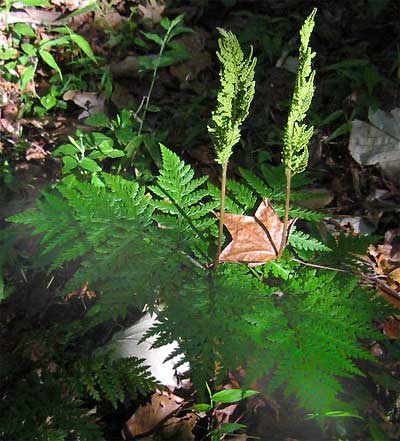Excerpts from Jim Conrad's
Naturalist Newsletter
from the January 14, 2008 issued from Yerba Buena Clinic just outside Pueblo Nuevo Solistahuacan, Chiapas, MÉXICO
about 1740 meters in elevation, ± LAT. 17° 11' 27"N, LONG. -92° 53' 35"W
RATTLESNAKE FERNS
We don't have rattlesnakes here but we do have rattlesnake ferns, two of whom you can see below.

The fronds in that picture are about 15 inches high, triangular in shape, and are first divided into three subsections, then those subsections are divided once or twice again. The dried leaf atop one frond is from a Sweetgum.
I've heard two explanations for their being called rattlesnake ferns. One is that their spore-producing spikes point skyward the way an upset rattlesnake's rattle might. The other is that those same spikes often are held bent to one side, pointing toward the nearest rattlesnake nest. Whatever the case, this fern has nothing to do with rattlesnakes. It's just a primitive form of fern with a curious way of presenting its spore-producing spikes, and as such it's always a pleasure to find.
The only rattlesnake fern listed for Yerba Buena is Botrychium decompositum, but the ferns I'm seeing look like North America's common rattlesnake fern, Botrypus virginiana, which also are found in Mexico, Central and South America, as well as Eurasia. B. decompositum's rattlesnake part arises from the stem well below the frond, while on our Rattlesnake Fern it arises at the base of the frond atop the stem. Since so many North American species are surviving in our "sky island" of relict organisms left over from the last ice age, I'm betting that our fern is the same as North America's Botrypus virginiana, or a subspecies thereof.
The fern's erect, stalked, spore-producing spikes are only one of its interesting, primitive features. When you scrape away a little humus from around the fern's base you see that its roots are unusually short and fleshy, like dingy spaghetti.
These unusual features reflect the fact that rattlesnake ferns arose so early in evolutionary history that the fern world hadn't yet "figured out" how to arrange its spore-producing sporangia in the modern manner of having neat little fruit-dots or sori on frond undersurfaces, and neither had they yet discovered how to produce the slender, much-branching, very efficiently absorbing roots typical of modern ferns.